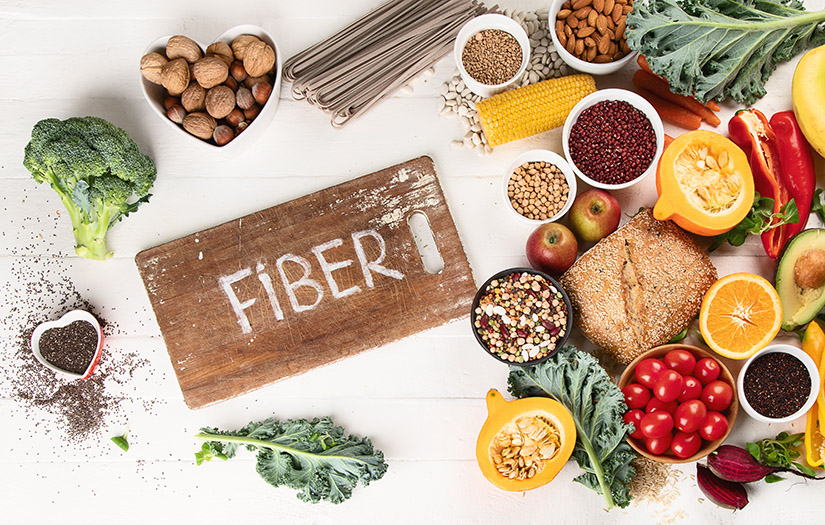You have likely seen food labels that say, “High in fiber!” These types of advertisements seem to suggest that something high in fiber must be healthy, but why? Does fiber matter? Am I getting enough of it in my diet? What types of foods have fiber?
This article aims to answer all these questions to simplify meeting your daily fiber intake needs. This info is key for all nutrition coaches, sports nutrition experts, or general health enthusiasts!
Learn more about other micronutrients here.
Why Fiber is Important
Fiber is a carbohydrate that doesn’t provide the body with energy. Rather, it passes through the stomach undigested and goes straight to the digestive tract. According to the Academy of Nutrition and Dietetics (2020), fiber plays an important role in:
• Reducing the risk of heart disease
• Helping with weight management
• Reducing the risk of diabetes, and
• Improving the digestion of food and passing of waste product
There are two types of fiber: soluble and insoluble. Soluble fiber dissolves in water and helps manage cholesterol levels, thus reducing the risk of heart disease. Insoluble fiber does not dissolve in water, and therefore increases the feeling of fullness and helps move food through your digestive system. If you get your fiber from a wide range of whole grains, fresh fruits and vegetables, legumes, and nuts, then you’ll likely consume both the right amounts and types of fiber for good health.
Women should try to eat at least 21 to 25 grams of fiber a day, while men should aim for 30 to 38 grams a day (Mayo Clinic 2021). According to the Harvard School of Public Health (2021), most Americans only get about 15 grams of fiber per day. This is likely due to an increase in the consumption of processed and fast foods over the past few decades.
By making a few food swaps in your diet and paying closer attention to labels, you can ensure that you meet your daily recommended fiber amounts to reap the health benefits.
12 Foods That Are High in Fiber
- Chia Seeds
- Raspberries
- Lentils or Black Beans
- Spaghetti
- Pear
- Broccoli
- Oatmeal
- Grean Peas
- Apple with Skin
- Potatoes
- Brussel Sprouts
- Almonds
I don’t know about you, but I used to associate fiber with bran products only. It could have been due to the food marketing that I was exposed to, but it made me think that I could only find fiber in cardboard-like foods. Thankfully, this isn’t the case! Here’s a list of vibrant foods that are choc-full of fiber AND flavor.
The following foods are listed in order from highest to lowest fiber content, relative to the average serving size for that food. While this doesn’t include every single food item that contains fiber, it will give you a great place to start as you plan your meals for the week.
#1 Chia seeds (10g per 1 oz)
Chia seeds are a great source of fiber, omega-3 fatty acids, and they also contain some protein. Sprinkle these super-seeds on a salad, mix them in a smoothie, or make a chia seed pudding for a little treat!
#2 Raspberries (8g per 1 cup)
These delicious berries are low in calories and packed with Vitamin C. They can be eaten by themselves or be used to top your favorite protein-packed yogurt for a nutritious snack.
#3 Lentils or Black Beans (7.5g and 7g, respectively per 1/2 cup cooked)
Lentils and black beans are great sources of fiber, protein, and important vitamins and minerals like Folate, Iron, Potassium, and Zinc.
#4 Spaghetti, whole-wheat (6g per 1 cup, cooked)
Although spaghetti is commonly thought of as part of a heavy and indulgent meal, it can be part of a healthy meal. Make a tomato-based sauce that includes chopped non-starchy vegetables (like onion, zucchini, bell peppers, or yellow squash), and a lean ground protein (like chicken or turkey), and you’ve got yourself a colorful, balanced meal!
#5 Pear (5.5g per 1 medium pear)
A medium-sized pear is only 100 calories, plus it contains Vitamin C and Potassium along with a good boost of fiber. Remember to eat the skin, too!
#6 Broccoli (5g per 1 cup chopped)
Broccoli is a cruciferous vegetable that also contains Vitamin C, Vitamin K, Iron, and Potassium. It also has more protein than other vegetables, coming in at 2.5g of protein per cup.
#7 Oatmeal (5g per 1 cup, cooked)
Oatmeal is an easy breakfast option. You can also add some chia seeds (for healthy fats and even more fiber!) and maybe even mix in some protein powder to make it a complete meal that will fuel your entire morning.
#8 Green peas (4.5g per 1/2 cup, cooked)
Green peas are a legume that also contains high amounts of Vitamin A and Vitamin K. Green peas are a great addition to stir-fries, or they can be eaten as a side dish.
#9 Apple, with skin (4.5g per 1 medium apple)
Apples are an easy on-the-go snack option since they don’t have to be refrigerated. In addition to fiber, apples also contain Vitamin C.
#10 Potato, with skin, baked (4g per 1 medium potato)
Baked potatoes get a bad reputation, but they can be a healthy option when not loaded with mounds of butter and sour cream. A plain baked potato is loaded with Vitamin B6, Potassium, and Vitamin C. Try using a small amount of butter (1 tsp) if desired, and sub plain Greek yogurt for sour cream for an extra protein boost.
#11 Brussels sprouts (4g per 1 cup, boiled)
One serving of this cruciferous vegetable contains 124% of the recommended Vitamin C per day. Try them roasted, shredded in a stir-fry, shredded and raw in a salad, or even microwave-steamed from the freezer section for ease!
#12 Almonds (3.5g per 1 ounce, or 23 nuts)
Hungry? Grab a handful of almonds with a piece of fruit! One serving, only 23 almonds, contains healthy fats, 6 grams of protein, Vitamin E, Manganese, and Magnesium.
Besides the foods listed, you can also find fiber in packaged foods, like whole-grain products. Read labels to keep track of how much fiber you’re consuming daily. Additionally, food tracking apps, like MyFitnessPal, can track your daily fiber intake along with your overall calorie and nutritional information for the day.
It’s wise to increase your fiber intake slowly and make sure that you drink plenty of fluids to avoid any digestive upsets.
For more information on almonds, see The Health Benefits of Almonds.
Is Fiber Good for Weight Loss?
If you’ve ever tried to lose weight, you know that feeling hungry makes it incredibly challenging to maintain a calorie deficit. Eating the recommended daily amount of fiber can help you feel fuller for longer, which can lead to an overall decrease in calories consumed. Therefore, eating a diet that has sufficient fiber can help you with weight loss!
Should You Take Fiber Supplements?
Fiber supplements can help you meet the daily recommended intake, but it’s best to rely on food sources as your primary fiber source.
Dr. Michael Picco with the Mayo Clinic (2020) recommends getting fiber from food rather than supplements “because supplements don’t provide the vitamins, minerals and other nutrients that fiber-rich foods do”. He also points out that fiber supplements can cause some digestive upset at first, so supplements should be taken in smaller amounts and with plenty of fluids until your body adjusts. As with any supplements, check with your doctor before adding them to your daily routine.
Adding these fiber-rich foods into your diet will not only help you gain the benefits of eating fiber, but you’ll also end up consuming a diet rich in the many vitamins and minerals that your body needs to thrive.
Also check out: Foods High in Iron
References
Academy of Nutrition and Dietetics. Fiber (2020, November 3). Retrieved from
https://www.eatright.org/food/vitamins-and-supplements/nutrient-rich-foods/fiber
Harvard School of Public Health. Fiber (2021). Retrieved from https://www.hsph.harvard.edu/nutritionsource/carbohydrates/fiber/
Mayo Clinic. Chart of high-fiber foods (2021, January 5). Retrieved from https://www.mayoclinic.org/healthy-lifestyle/nutrition-and-healthy-eating/in-depth/high-fiber-foods/art-20050948
Michael Picco. Healthy lifestyle: Nutrition and healthy eating (2020, December 22). Retrieved from https://www.mayoclinic.org/healthy-lifestyle/nutrition-and-healthy-eating/expert-answers/fiber-supplements/faq-20058513

















